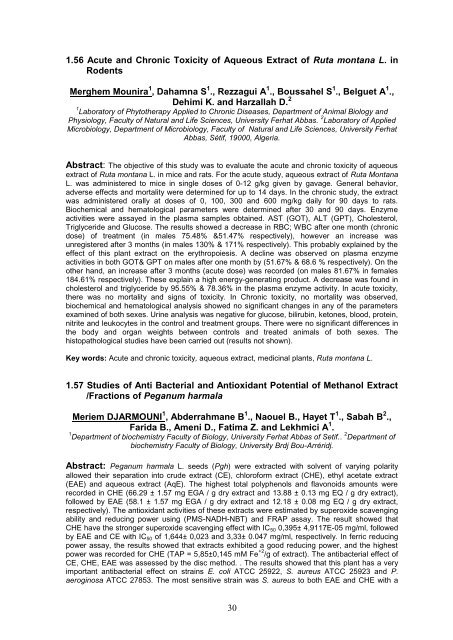Abstract Book - 3rd International Symposium on Medicinal Plants ...
Abstract Book - 3rd International Symposium on Medicinal Plants ...
Abstract Book - 3rd International Symposium on Medicinal Plants ...
You also want an ePaper? Increase the reach of your titles
YUMPU automatically turns print PDFs into web optimized ePapers that Google loves.
1.56 Acute and Chr<strong>on</strong>ic Toxicity of Aqueous Extract of Ruta m<strong>on</strong>tana L. in<br />
Rodents<br />
Merghem Mounira 1 , Dahamna S 1 ., Rezzagui A 1 ., Boussahel S 1 ., Belguet A 1 .,<br />
Dehimi K. and Harzallah D. 2<br />
1 Laboratory of Phytotherapy Applied to Chr<strong>on</strong>ic Diseases, Department of Animal Biology and<br />
Physiology, Faculty of Natural and Life Sciences, University Ferhat Abbas. 2 Laboratory of Applied<br />
Microbiology, Department of Microbiology, Faculty of Natural and Life Sciences, University Ferhat<br />
Abbas, Sétif, 19000, Algeria.<br />
<str<strong>on</strong>g>Abstract</str<strong>on</strong>g>: The objective of this study was to evaluate the acute and chr<strong>on</strong>ic toxicity of aqueous<br />
extract of Ruta m<strong>on</strong>tana L. in mice and rats. For the acute study, aqueous extract of Ruta M<strong>on</strong>tana<br />
L. was administered to mice in single doses of 0-12 g/kg given by gavage. General behavior,<br />
adverse effects and mortality were determined for up to 14 days. In the chr<strong>on</strong>ic study, the extract<br />
was administered orally at doses of 0, 100, 300 and 600 mg/kg daily for 90 days to rats.<br />
Biochemical and hematological parameters were determined after 30 and 90 days. Enzyme<br />
activities were assayed in the plasma samples obtained. AST (GOT), ALT (GPT), Cholesterol,<br />
Triglyceride and Glucose. The results showed a decrease in RBC; WBC after <strong>on</strong>e m<strong>on</strong>th (chr<strong>on</strong>ic<br />
dose) of treatment (in males 75.48% &51.47% respectively), however an increase was<br />
unregistered after 3 m<strong>on</strong>ths (in males 130% & 171% respectively). This probably explained by the<br />
effect of this plant extract <strong>on</strong> the erythropoiesis. A decline was observed <strong>on</strong> plasma enzyme<br />
activities in both GOT& GPT <strong>on</strong> males after <strong>on</strong>e m<strong>on</strong>th by (51.67% & 68.6 % respectively). On the<br />
other hand, an increase after 3 m<strong>on</strong>ths (acute dose) was recorded (<strong>on</strong> males 81.67% in females<br />
184.61% respectively). These explain a high energy-generating product. A decrease was found in<br />
cholesterol and triglyceride by 95.55% & 78.36% in the plasma enzyme activity. In acute toxicity,<br />
there was no mortality and signs of toxicity. In Chr<strong>on</strong>ic toxicity, no mortality was observed,<br />
biochemical and hematological analysis showed no significant changes in any of the parameters<br />
examined of both sexes. Urine analysis was negative for glucose, bilirubin, ket<strong>on</strong>es, blood, protein,<br />
nitrite and leukocytes in the c<strong>on</strong>trol and treatment groups. There were no significant differences in<br />
the body and organ weights between c<strong>on</strong>trols and treated animals of both sexes. The<br />
histopathological studies have been carried out (results not shown).<br />
Key words: Acute and chr<strong>on</strong>ic toxicity, aqueous extract, medicinal plants, Ruta m<strong>on</strong>tana L.<br />
1.57 Studies of Anti Bacterial and Antioxidant Potential of Methanol Extract<br />
/Fracti<strong>on</strong>s of Peganum harmala<br />
Meriem DJARMOUNI 1 , Abderrahmane B 1 ., Naouel B., Hayet T 1 ., Sabah B 2 .,<br />
Farida B., Ameni D., Fatima Z. and Lekhmici A 1 .<br />
1 Department of biochemistry Faculty of Biology, University Ferhat Abbas of Setif.. 2 Department of<br />
biochemistry Faculty of Biology, University Brdj Bou-Arréridj.<br />
<str<strong>on</strong>g>Abstract</str<strong>on</strong>g>: Peganum harmala L. seeds (Pgh) were extracted with solvent of varying polarity<br />
allowed their separati<strong>on</strong> into crude extract (CE), chloroform extract (CHE), ethyl acetate extract<br />
(EAE) and aqueous extract (AqE). The highest total polyphenols and flav<strong>on</strong>oids amounts were<br />
recorded in CHE (66.29 ± 1.57 mg EGA / g dry extract and 13.88 ± 0.13 mg EQ / g dry extract),<br />
followed by EAE (58.1 ± 1.57 mg EGA / g dry extract and 12.18 ± 0.08 mg EQ / g dry extract,<br />
respectively). The antioxidant activities of these extracts were estimated by superoxide scavenging<br />
ability and reducing power using (PMS-NADH-NBT) and FRAP assay. The result showed that<br />
CHE have the str<strong>on</strong>ger superoxide scavenging effect with IC 50 0,395± 4,9117E-05 mg/ml, followed<br />
by EAE and CE with IC 50 of 1,644± 0,023 and 3,33± 0.047 mg/ml, respectively. In ferric reducing<br />
power assay, the results showed that extracts exhibited a good reducing power, and the highest<br />
power was recorded for CHE (TAP = 5,85±0,145 mM Fe +2 /g of extract). The antibacterial effect of<br />
CE, CHE, EAE was assessed by the disc method. . The results showed that this plant has a very<br />
important antibacterial effect <strong>on</strong> strains E. coli ATCC 25922, S. aureus ATCC 25923 and P.<br />
aeroginosa ATCC 27853. The most sensitive strain was S. aureus to both EAE and CHE with a<br />
30

















